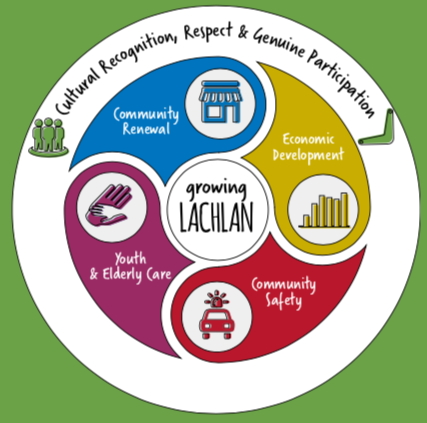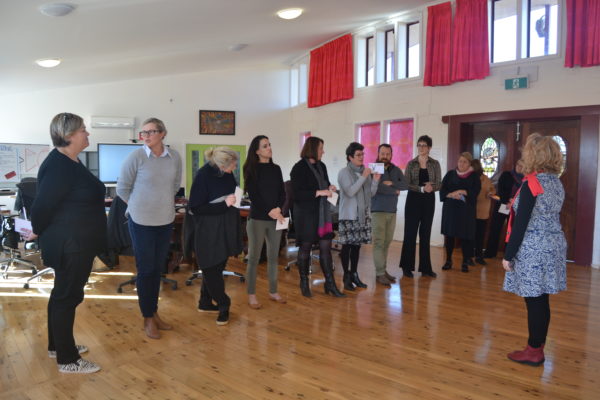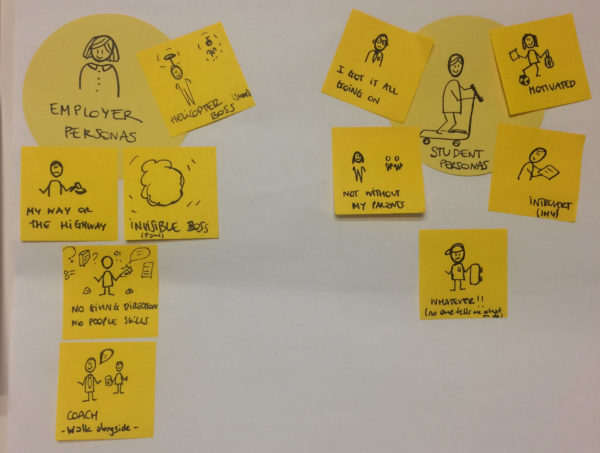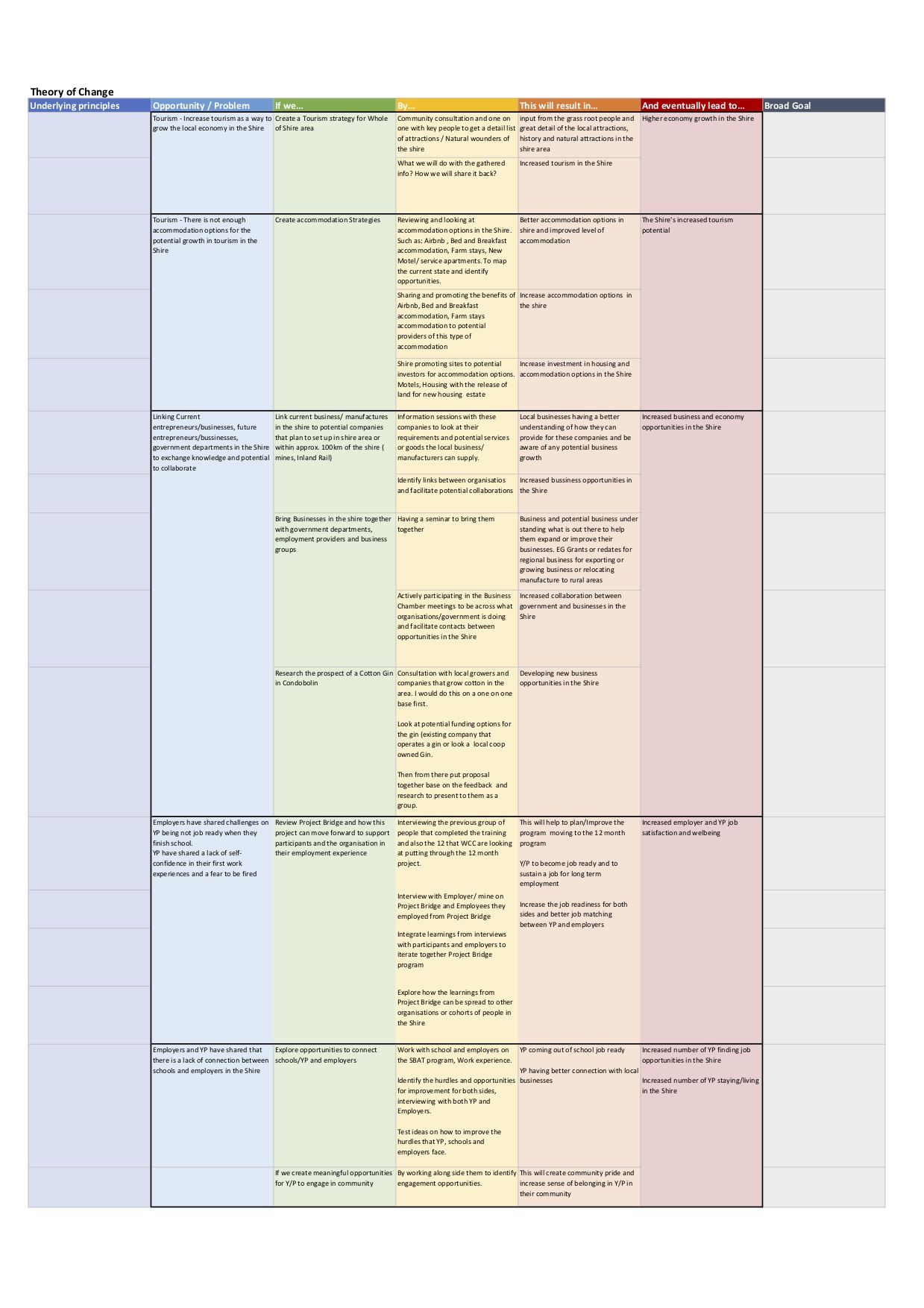Context: Why did the team in the Lachlan Shire start this piece of work?
Vincent Fairfax Family Foundation’s (VFFF) is committed to explore pathways to address entrenched social disadvantage in regional and remote communities in NSW. The foundation approached Lachlan Shire to undertake a community consultation to understand the community’s current state.
The aim was to understand the existing social challenges and to explore pathways to address those. This is how the Growing Lachlan team and Alliance was formed.

Phases of Growing Lachlan
1.Conversations and data analysis
As part of the Collective Impact approach, the Growing Lachlan team began <insert year?> with an analysis of Lachlan Shire’s quantitative data. This data helped identify the local social challenges to explore based on what the numbers were showing.
After that, the team held a range of conversations and provided questionnaires to people and representatives in the community, asking what really mattered to them and why. The team wanted to understand if the stories that the data was showing were real, and to what extent they were impacting the community.
The team analysed the responses and named the most common threads. Through this work, ten themes were initially identified.
Community input across the Shire prioritised the following five themes:
– Investing in community renewal
– Supporting economic sustainability and development
– Improving community safety and crime prevention
– Taking care of older and younger generations and
– Strengthening cultural recognition, respect and genuine participation.
The team acknowledged that none of these sits in isolation from the others, there is an overlap across them.
These themes frame a shared understanding on focus areas that can be addressed collectively.

2. Regional Innovators Network
Growing Lachlan Alliance was one of the first groups to get involved in the Regional Innovator’s Network in December 2016. Lake Cargelligo and Condobolin Community Connectors work closely together, and a lot of the activities happening in each site are shared between Shane Phillips (Lake Cargelligo Community Connector) and Annette Ohlsen (Condobolin Community Connector).

Currently there are three innovation projects happening in these two communities, each at different stages of the innovation journey:
- NAIDOC ball: an innovation project that was tested and implemented. Currently there is another team that will be running a second annual ball.
- School Based Apprenticeships and Training (SBAT): this project links employers and young people through schools, and is in a co-design and testing stage with students and local business.
- Economic development: this project is looking more broadly at economic opportunity in the shire, and is an initial definition and discovery stage.

NAIDOC ball
Shane worked with other community groups to organise the first NAIDOC ball in Lake Cargelligo. Shane worked to lay the groundwork and create the conditions to facilitate the needed mindsets in the community. A key element was the intentionality that Shane followed in every step in the process, including building a Theory of Change to frame the holistic scope and outcomes of this work.
The NAIDOC ball took place in November 2017 and was a success. Tickets were sold out and everything ran smoothly. Young people took organisational and delivery roles in the event. The event celebrated culture and increased the sense of belonging and pride for the local community — while building the skills and capabilities of young people.
There is a new team organising the 2018 NAIDOC ball. Growing Lachlan is taking a role to share the knowledge from the previous experience.
School Based Apprenticeships and Training (SBAT)
Exploring the ‘Youth and elderly care’ theme named in the first Growing Lachlan report, Shane identified an opportunity to work with young people in Lake Cargelligo High School. The SBAT program was already running, but there wasn’t a clear definition on what the SBAT program was set-up to achieve or how to connect young people with meaningful employment – which has been one of the big challenges in the area for a long time now. The person in charge had an interest in exploring how things could be done differently in engaging young people in meaningful employment in the community.
As a starting point, Shane held conversations with young people to gather information on:
- what are young peoples’ aspirations?
- how do they currently feel about employment options in their hometown?
- what can we learn from people who have already taken part in SBAT?
- what can our service system tell us about SBAT and how they work?
- what are young peoples’ experiences in looking for employment in the community? what is helping and what is hindering them in those experiences?
- what is the value that they are expecting to receive from SBAT?
- what are young peoples’ worries in gaining employment in the community?
- what barriers do they have to engage with SBAT?
In order to gather and analyse the information, Shane used the Value Proposition tool available under the Tools section.
After an initial understanding of the current context and experience for these young people, Shane facilitated a range of workshops with high school students to develop opportunities and ideas that could be tested in a new SBAT format.
To synthesise all the learnings, Shane framed some themes that came up for young people and the value proposition for them. This helped to describe the value that students were expecting to get from the program.
Another key stakeholder in the SBAT program is employers. Shane and Annette met with employers to ask them the same questions that they asked young people: what are employer’s needs? what is the value that they are expecting to receive from SBAT? what are their worries? what barriers do they have to engage with SBAT?
To synthesise what they heard from employers, Shane framed a series of themes and a value proposition.
Another key tool in this synthesis process was the Personas. These are archetypes of young people and employers in the community. Building these profiles will support the Growing Lachlan team to frame, co-design and test ideas that are focused on the different people cohorts in the community.
Employer Personas:
- No giving direction, no people skills
- My way or the highway
- The push-over
- The coach – walking alongside
- The invisible
- The helicopter
Young people Personas:
- Whatever! – No one tells me what to do
- Introvert – shy
- Motivated
- I got it all going on
- Not without my parents

Shane has also developed a Theory of Change for the SBAT prototype. Through this exercise, we framed the opportunities and problems that the SBAT prototype is looking to tackle, the broader goal and the lines of strategy that will lead to the desired goal. We also framed the assumptions we are holding and that will need to be tested moving forward.
Read information about working with assumptions and creating a Theory of Change.
Currently, Shane and Annette are exploring opportunities to take a similar approach in another community in the Shire, Tottenham.
Economic development
Growing Lachlan Alliance has identified the relevance to focus on the “Economic development” theme based on the state of economic opportunities around the Shire.
Annette started this work by meeting with different businesses and key stakeholders in the community to identify the economic development challenges and opportunities in the Shire. In order to synthesise and make the gathered information actionable, Annette has started to frame a Theory of Change. A Growing Lachlan Alliance subcommittee has been created to progress this work. This is the WIP TOC:

Systemic approach
Alongside these innovation projects, Shane and Annette are exploring other social change avenues that are linked to the initial themes framed in the Growing Lachlan report. These are projects that other people are doing, which they are linking to the Growing Lachlan work. They are also identifying projects that have the potential to become future innovation projects for Growing Lachlan. Linked or potential projects include:
- Engaging the young people and the community in Tottenham. Annette is exploring opportunities with local young people to engage them in the community, such as creating a mural for a local building in the community and involving young people in local committees
- Early intervention services. The team is exploring the early intervention services available in the schools across the Shire. Getting a clear view on this could then lead to talking to families and community to understand the gaps and create ideas to fill those gaps
- Youth and age care services. The team has also done some work to map youth and elderly services in the Shire. The objective is to visualise what is there, mapping potential duplications and gaps
- Working alongside other services in the Shire such as Down the Track and Project Bridge to build the capability on RIN mindsets, skills and process that they could draw on in their work
Growing Lachlan learnings and achievements
The team has reflected on the following learnings:
- Celebrate the big and the small
- Record your process – pictures, storyboards whatever works
- Relationships are critical to sustain true change and shifts in thinking, systems and practice
- Go where the energy is
- Don’t sweat the small stuff or the setbacks – there’s opportunity in everything
- Change is possible – even when you are consistently challenged and it seems impossible
- True innovation responses require mindset shifts, intentionality, self awareness, willingness to start somewhere and a motivation to learn from the lived experience
- Stay seated at the table even when the conversations/work feels hard or uncomfortable
- Have a shared agenda/broad goal

Some of the Growing Lachlan achievements have been:
- Launching the Growing Lachlan report that synthesised community input and described the five themes that the team is focusing on
- Growing Lachlan presented as part of a citizen panel and learning circles at a 2017 collective impact conference
- Interagency groups are shifting to better outcomes
- Moving forward services and housing for domestic violence victims are available
- Improved facilities for young people in Condobolin and Lake Cargelligo: new skate park and park upgrades
- Down the Track program implemented in Lake Cargelligo and Condobolin
- Cuppa with a Cop initiative implemented in Condobolin
- NAIDOC ball in Lake Cargelligo and NAIDOC full week of community celebrations in Condobolin
- Young people’s murals in Condobolin, Tottenham and Lake Cargelligo
- ANZAC acknowledgement to Aboriginal soldiers
What now and what next?
The following months will involve prototyping and testing the SBAT prototype with employers and young people. This will also mean exploring the systemic lens — that is, engaging with stakeholders across organisations and institutions in the community whose work influences and is linked to young people looking for employment. The broad goal is to achieve the following outcomes for young people: increased meaningful employment opportunities locally, increased sense of belonging and pride in their community.
The team will also continue to explore and action the strategy pathways defined in the Economic Development theory of change. Part of this will involve meeting with previous Bridge Project participants, which is a program offered by Cowal Gold Mine and the Wiradjuri Condobolin Corporation (WCC) to coach and support Aboriginal people in the community to transition to job opportunities in the mining industry. The objective of meeting with these participants is to understand the lessons learned that would be valuable for the community to consider in moving forward with the Economic development theory of change. Another activity will be prototyping and testing by hosting a business and community forum together with other community partners.
Shane and Annette are also starting to explore a systems mapping approach to understand how the different projects in the community are contributing towards Growing Lachlan focus areas. The objective is to understand overlaps and leverage points that they could follow-up with the involved groups. The team envisions an opportunity to share what is happening across the shire with the community.
For more information
Contact Shane Phillips, Lake Cargelligo Community Connector on ccolake@gmail.com and Annette Ohlsen, Condobolin Community Connector on ccogrowinglachlan@gmail.com to explore further details on this work.